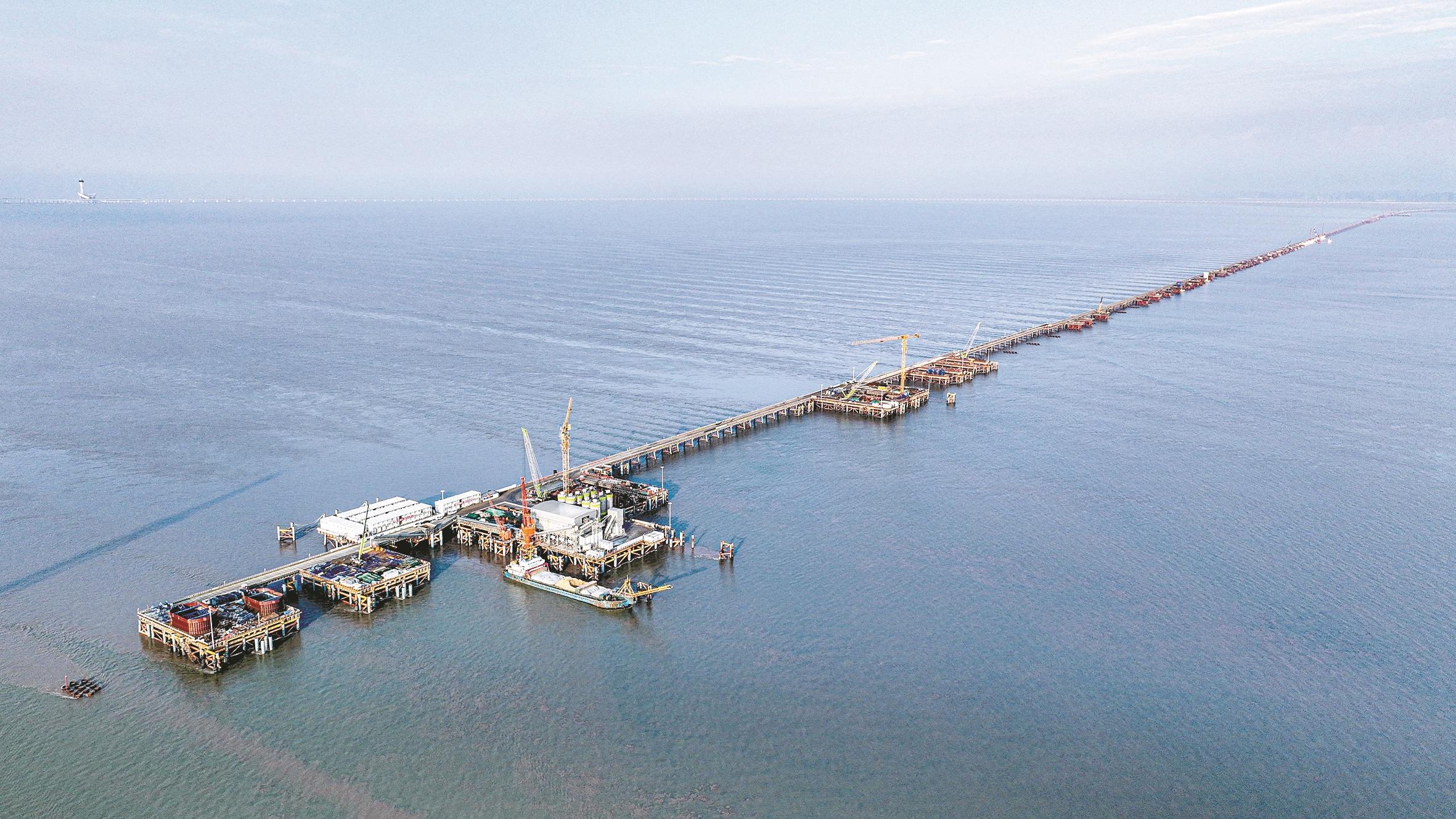By Zhao Yu
The sun sets over the sea in a blaze of gold. But on a 32,000-square-meter offshore platform in the middle of the Hangzhou Bay—home to more than 200 workers—few have time to admire the view.
Though it appears like a small island, the platform is no island at all. It is the marine base for the construction of the Hangzhou Bay Cross-Sea Railway Bridge, a centerpiece of the Tongxiang-Suzhou-Jiaxing-Ningbo Railway Corridor.
Bridging 19 Years, Spanning 13 Kilometers
From the platform, the Hangzhou Bay Bridge—about 13 kilometers to the east—comes faintly into view. Construction began in 2003, and the road bridge opened on May 1, 2008. Now, 19 years later, work has begun on its successor: a new railway bridge.
"This is a world-class project. I wanted to be part of it," said Xiao Yizhong, deputy chief engineer of the railway bridge. "Last October, the first steel cofferdam for the south navigation channel bridge was lowered. It was one of the most technically challenging parts of the entire project," Xiao explained.
The challenge lay in the sheer scale and complexity of the task. The cofferdam weighed 2,500 tons and covered an area equivalent to five basketball courts, the largest in China. The water head difference inside and outside the structure reached 25 meters, creating significant pressure differentials that made the operation extremely demanding.
Installing a steel cofferdam is like placing a massive box on the seabed. Once secured to the underwater pile foundations, concrete is poured into its base while seawater inside is pumped out, creating a temporary artificial island. Xiao devised a new technic to significantly improve construction efficiency. "The first steel cofferdam took two days to lower, the second only about 20 hours – cutting the time by more than half," he said.
Another experienced engineer, Wang Dongsong, chose to join the project on his own initiative. "If the bridge were a living being, concrete would be its flesh and blood," he said. Wang is the one responsible for producing that "flesh and blood".
The Hangzhou Bay presents tough environmental conditions—wide tidal ranges, strong currents, and severe erosion. The difference between high and low tide can reach up to 8.69 meters, and water flows at speeds up to 5.3 meters per second. These natural forces place extraordinary demands on the durability of the concrete. Wang recalled the lab tests carried out for the earlier road bridge. He and his team spent over a year conducting more than 500 tests to find a high-performance formula that would withstand the harsh marine environment. The final formulations were successfully used in that project.
Now approaching retirement, Wang sees the railway bridge as his final professional chapter. "I don't want to leave any regrets," he said. He visits the offshore platform every two days on average, overseeing samples and testing to ensure every batch meets the highest standards. According to current estimates, the concrete developed for the railway bridge could last up to 150 years—well beyond the original 100-year design life.
Days and Nights at the Heart of the Sea
Yang Chengzheng considers himself "lucky" to have secured a "sea-view room" on the offshore platform from the start, sparing him the daily 40-minute boat ride through choppy waters.
Unlike traditional bridge construction, which typically advances from one end to the other, offshore railway bridge work often begins in the middle to improve both efficiency and safety. Rather than ferrying workers and materials back and forth each day, building an artificial island at sea is the more practical solution.
By the end of 2023, after five months of assembly, the offshore platform was complete. Yang Chengzheng arrived on the platform that December, along with his team leader, Xiang Zhongping. "When I first arrived, it was so dreary that I could hardly smile," This optimistic man from Sichuan initially found his smile dampened by the waves.
Currently, two teams are stationed on the platform. Xiang's larger crew, with around 130 workers, is responsible for tasks such as tying rebar and pouring concrete. Within two months, the team faced their first major challenge: the underwater pouring of the 4-meter-thick base slab for Pier 160 of the south navigation channel bridge. This initial pour required 5,440 cubic meters of concrete.
Concrete pouring might seem routine, but in this case, the success of this pour was critical to transforming the interior of the steel cofferdam into a dry work area – it had to be absolutely watertight. Xiang recalls the intensity of the 30-hour pour: "I barely slept. I stayed on site the entire time," he said. Once pouring begins, not a minute can be lost.
Fortunately, the trestle bridge was completed 10 days before the base slab pour. This 10.96-kilometer-long trestle bridge connects two 180-model land-based mixing stations to two 180-model offshore mixing stations, supplying a constant stream of concrete to the site. It became an "umbilical cord" to the heart of the sea—delivering construction materials, skilled workers, and even the crew's daily meals.
Megaproject Meets Mega-Machinery
Boom, boom, boom... As dusk settles over the bay, the deep, rhythmic pounding from distant pile-driving vessels echoes across the water.
For a railway bridge to stand firm in the stormy, high-surge waters of Hangzhou Bay, a solid foundation is essential. "Our solution is to drive longer piles, embedding them deep into the seabed," explained Xiao. That may sound simple, but driving piles nearly 150 meters long demands extraordinary capabilities from the pile-driving vessels—capabilities that only four vessels in China currently possess. Thanks to careful coordination by the project team, three of them were deployed for this project: the Shuixin Qi 1, Xiongcheng 3, and Xiongcheng 1.
On March 1, the newly-commissioned Erhang Changqing—the world's largest pile-driving vessel—drove its first pile into the waters of Hangzhou Bay.
The engineer Zhang Wei pulled out his phone to double-check the tide charts, calculating the earliest safe window to begin work. Once the first pile was successfully driven into place, his nerves finally eased. Over the past three months, the Erhang Changqing has driven 160 pile foundations.
Construction continues—driving piles, erecting piers, laying tracks. "When the rail bridge is complete, crossing the bay will take just five minutes," said Zhang. But for the builders, that five-minute journey will take five years of work to realize.



